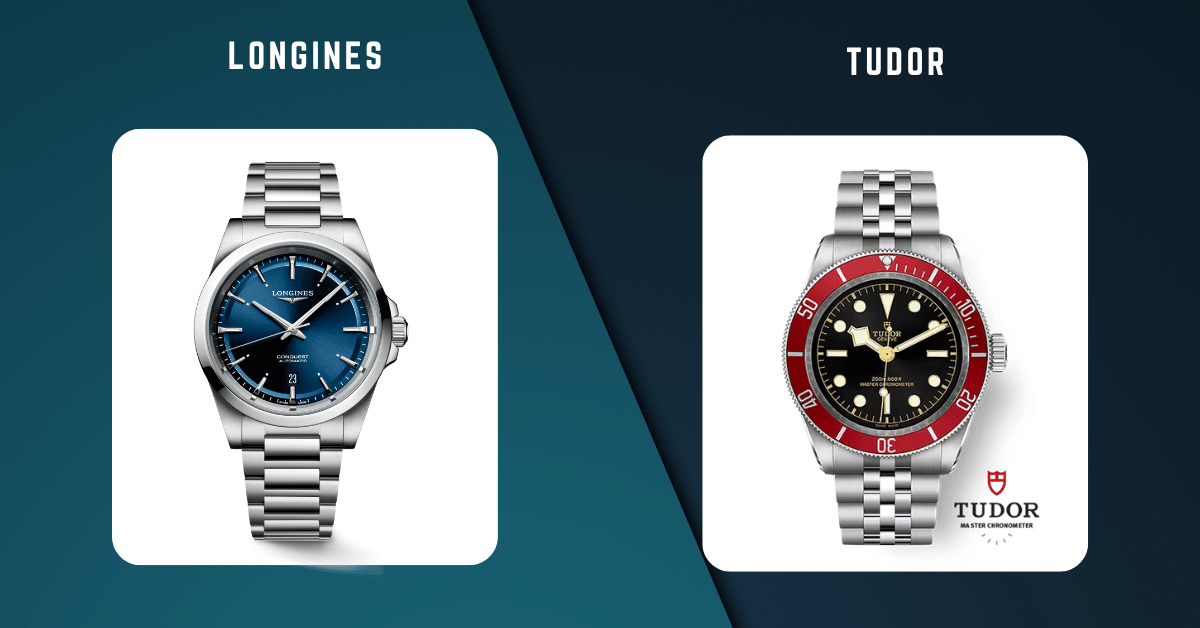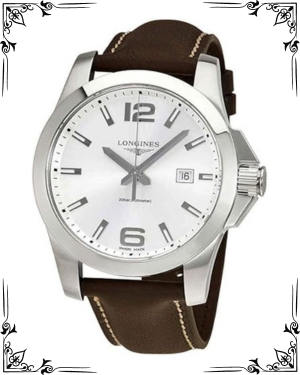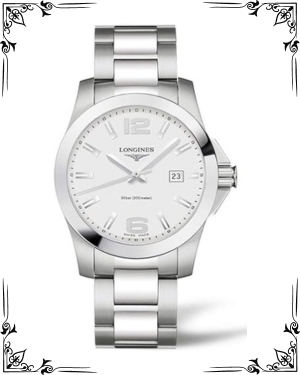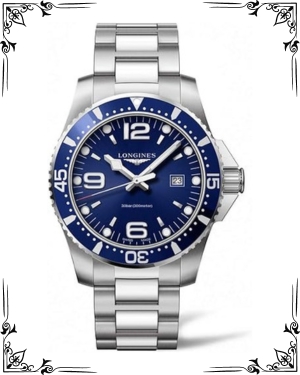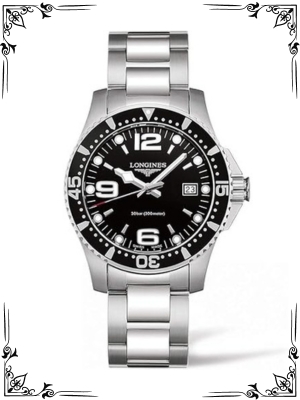Today, we embark on a journey to compare two prestigious Swiss watchmakers – Longines and Tudor. Both brands boast a rich heritage, exceptional craftsmanship, and a diverse range of timepieces coveted by collectors worldwide.
But with so much to admire, how do you choose your champion? Fear not, for by the end of this in-depth analysis, you’ll be a master of Longines and Tudor knowledge, equipped to select the timepiece that perfectly aligns with your taste and watch collecting goals.
Look Back at Longines and Tudor’s History
Before diving into the technical specifications, let’s explore the unique stories these brands bring to the table:
Longines: Established in 1832 in Saint-Imier, Switzerland, Longines boasts a long and distinguished history. They are renowned for their elegance, innovation, and commitment to quality. Longines has played a significant role in the development of sports timing and is an official timekeeper for various sporting events around the world.
Tudor: Founded in 1946 by Hans Wilsdorf, the founder of Rolex, Tudor was created with a mission to offer high-quality, affordable Rolex alternatives. Tudor shares some manufacturing resources with Rolex, benefiting from their expertise while carving their own distinct identity.
Tudor is known for their sporty and toolish watches, with a growing reputation for heritage-inspired designs.
Here’s a table summarizing the key historical aspects:
| Feature | Longines | Tudor |
|---|---|---|
| Founding Year | 1832 | 1946 |
| Known For | Elegance, Innovation, Quality, Sports Timing | Affordable Rolex Alternative, Sporty Watches, Heritage Inspiration |
Under the Hood: A Technical Breakdown
Let’s equip ourselves with the knowledge to navigate the technical specifications of Longines and Tudor timepieces. Here’s a close examination of their core functionalities:
Movement
Longines: Longines primarily utilizes Swiss-made automatic movements. These movements are known for their reliability and accuracy, offering a convenient alternative to battery-powered quartz movements.
Longines often utilizes movements from reputable suppliers like ETA or Sellita, ensuring quality and performance. While some higher-end Longines models might incorporate in-house movements, these are less common.
Tudor: Tudor offers a more diverse approach to movements. They utilize a mix of in-house manufactured calibers and high-quality ETA-based movements. Their in-house movements boast impressive power reserves and chronometer certification, signifying superior accuracy. The ETA-based movements offer a reliable and cost-effective option in some Tudor models.
Here’s a table summarizing the key movement aspects:
| Feature | Longines | Tudor |
|---|---|---|
| Movement Strategy | Primarily Swiss-made automatic (ETA/Sellita) | Mix of in-house and ETA-based movements |
| Notable Feature (Longines) | Reliable and accurate timekeeping | |
| Notable Feature (Tudor) | In-house movements (power reserve, chronometer certification) |
Materials and Construction
Both Longines and Tudor prioritize high-quality materials in their watches. They predominantly utilize 316L stainless steel for their cases and bracelets, ensuring durability and corrosion resistance. Some models might incorporate high-end materials like ceramic, titanium, or gold for a more luxurious feel.
Both brands are known for their meticulous finishing. Longines often feature a polished finish for a sophisticated aesthetic, while Tudor might incorporate a mix of polished and brushed finishes depending on the model’s sporty or heritage-inspired design.
Here’s a table summarizing the key materials and construction aspects:
| Feature | Longines & Tudor |
|---|---|
| Case Material | Primarily 316L stainless steel (high-end options available) |
| Bracelet Material | Primarily 316L stainless steel (high-end options available) |
| Crystal | Sapphire Crystal (scratch-resistant) |
| Finishing | Longines (polished), Tudor (mix of polished and brushed finishes) |
Functions and Features
Longines: Longines offers a diverse range of timepieces, but they are generally known for their classic dress watches and sporty tool watches. Their dress watches typically feature basic timekeeping functions with hour, minute, and second hands.
Some models might incorporate additional features like a date complication or a power reserve indicator. Longines’ sports watches, like the Hydroconquest, offer water resistance for diving and other adventurous activities.
Tudor: Tudor is renowned for their sporty and toolish watches. Their iconic Black Bay line, for example, draws inspiration from vintage dive watches, offering impressive water resistance, a unidirectional rotating bezel for tracking dive times, and luminous hands and markers for excellent low-light readability.
Tudor also offers chronographs, pilot’s watches, and GMT watches for those seeking additional functionalities. While they have some dress watch options, these are not as prominent in their overall collection compared to Longines.
Here’s a table summarizing the key dial design aspects:
| Feature | Longines | Tudor |
|---|---|---|
| Overall Aesthetic (Dress Watches) | Clean, elegant | Sporty, functional |
| Overall Aesthetic (Sporty Watches) | Clean, legible (Hydroconquest) | Sporty, vintage-inspired (Black Bay) |
| Hour Markers (Dress Watches) | Roman numerals or applied markers | Arabic numerals |
| Hour Markers (Sporty Watches) | Bold Arabic numerals with luminous markers | Bold Arabic numerals with luminous markers |
Case and Bracelet
Longines: Longines cases come in a variety of styles, with their dress watches typically featuring sleek and polished profiles. The case size might vary depending on the model, but it generally caters to a wider range of wrist sizes.
Sporty Longines models, like the Hydroconquest, have a thicker profile for enhanced water resistance and functionality. Longines bracelets are well-constructed and comfortable to wear, often featuring a folding clasp with additional safety features.
Tudor: Tudor cases are known for their robustness and functionality. The Black Bay line, for example, features a distinctive case design inspired by vintage dive watches. Tudor offers a wider range of case sizes compared to Longines, catering to those who prefer a more substantial wrist presence.
Tudor bracelets are typically robust and secure, offering a comfortable fit for various activities. Some models might incorporate vintage-inspired rivet bracelets for a unique aesthetic.
Here’s a table summarizing the key case and bracelet aspects:
| Feature | Longines | Tudor |
|---|---|---|
| Case Design (Dress Watches) | Sleek, polished | Robust |
| Case Design (Sporty Watches) | Thicker profile for functionality (Hydroconquest) | Robust, inspired by vintage dive watches (Black Bay) |
| Focus (Dress Watches) | Refined aesthetics | Functionality |
| Focus (Sporty Watches) | Functionality, vintage inspiration | Functionality, vintage inspiration |
| Bracelet | Well-constructed, comfortable, folding clasp | Robust, secure, folding clasp (vintage-inspired rivet bracelets on some models) |
Brand Image
Longines: Longines cultivate an image of heritage, elegance, and accessibility. Owning a Longines signifies an appreciation for quality Swiss timepieces with a rich history. The brand offers a good balance between traditional watchmaking and contemporary design.
Tudor: Tudor has a more sporty and adventurous brand image. Owning a Tudor signifies an appreciation for robust, well-made timepieces designed for active lifestyles. Tudor also cultivates a growing reputation for heritage-inspired designs, particularly with their Black Bay line.
This appeals to watch enthusiasts who appreciate vintage aesthetics with modern functionality. Overall, Tudor offers a more niche brand image compared to Longines, catering to those who value sporty style and a distinct identity.
Popular Models of Longines and Tudor
Both Longines and Tudor offer a wide range of timepieces to suit various tastes and budgets. Here are some of their most popular models:
Longines
Longines Hydroconquest: The Longines Hydroconquest is a stylish and affordable dive watch that’s perfect for everyday wear. It’s water-resistant to 300 meters and features a unidirectional rotating bezel, a screw-down crown, and a variety of dial colors and bracelet options.
Longines Spirit: The Longines Spirit is a collection of pilot’s watches inspired by vintage aviation timepieces. It features a variety of case sizes, dial colors, and movement options, including automatic and chronograph movements.
Longines Master Collection: The Longines Master Collection is a collection of elegant dress watches that are perfect for everyday wear. It features a variety of case sizes, dial colors, and movement options, including automatic and quartz movements.
Longines DolceVita: The Longines DolceVita is a collection of rectangular watches known for their sleek and elegant design. It’s a perfect choice for those who want a watch that makes a statement.
Longines La Grande Classique de Longines: A timeless collection of dress watches known for their clean lines and simple elegance. They are ideal for those seeking a versatile watch that can be dressed up or down.
Tudor
Black Bay: The Tudor Black Bay is a collection of dive watches inspired by vintage Rolex models. It’s known for its robust construction, stylish design, and excellent value for money. The Black Bay comes in a variety of case sizes, materials, and dial colors.
Pelagos: The Tudor Pelagos is a professional dive watch that’s water-resistant to 500 meters. It features a titanium case, a helium escape valve, and a ceramic bezel.
Black Bay GMT: A popular choice for frequent travelers, the Black Bay GMT is a GMT watch that allows you to track the time in two different time zones. It features a robust build, a stylish design, and a user-friendly GMT complication.
Royal: The Tudor Royal is a collection of dress watches that offer a touch of luxury at an attainable price point. It features a variety of case sizes, materials, and dial colors, with some models featuring diamonds.
Ranger: The Tudor Ranger is a collection of field watches inspired by military timepieces. It’s known for its simple design, robust construction, and excellent legibility.
These are just a few of the many popular models from Longines and Tudor. Both brands offer a wide variety of watches to suit different styles and budgets. Consider your needs and preferences when choosing between these two well-respected Swiss watchmakers.
User Feedback: Voices from the Watch Community
Let’s delve into the real-world experiences of watch enthusiasts who own either Longines or Tudor timepieces:
Longines: Owners often praise the classic and elegant design of Longines dress watches, particularly the versatility they offer for various occasions. The comfort and wearability of Longines watches are also highly regarded.
Some might find the feature set limited compared to more complex timepieces. For sporty models like the Hydroconquest, users appreciate the value proposition and the watch’s ability to handle active lifestyles.
Tudor: Tudor is celebrated for its excellent value proposition, offering robust and functional timepieces, particularly the Black Bay line, at a competitive price point compared to similar offerings from Rolex. The vintage-inspired aesthetics and the overall quality of the build are other points of praise.
Some might find the bolder design of Tudor watches less suitable for formal occasions. Additionally, the in-house movements on some higher-end Tudor models are lauded for their performance and accuracy.
Common Problems: Potential Concerns
While both Longines and Tudor are known for their quality, it’s wise to consider potential drawbacks:
Longines: As primarily dress watches or tool watches with a focus on essential functionality, Longines might not be ideal for those seeking highly complex timepieces with intricate complications. For a truly feature-rich watch, Tudor might be a better choice.
Additionally, the polished finish on some Longines dress watches might be susceptible to scratches for those with very active lifestyles.
Tudor: The larger case sizes on some Tudor models, particularly the Black Bay line, might not be suitable for all wrist sizes or preferences. Those with smaller wrists might find Longines’ offerings to be a better fit. Additionally, the sporty and vintage-inspired aesthetics of Tudor might not align with everyone’s style preferences, particularly those seeking a more classic and timeless look.
The Final Lap: Choosing Your Champion
With a comprehensive understanding of Longines and Tudor, you’re well-equipped to make an informed decision:
Choose Longines if:
- You prioritize a classic and elegant timepiece for dressy occasions and everyday wear.
- You appreciate a clean and legible dial with essential timekeeping functions.
- You have a medium-sized wrist and prefer a comfortable and sleek design.
- You value a balance between heritage and contemporary design.
Choose Tudor if:
- You value a robust and functional timepiece for active lifestyles and adventurous activities.
- You appreciate a sporty aesthetic with features like a unidirectional bezel and luminous markers (Black Bay line).
- You have a larger wrist and prefer a watch with a substantial presence.
- You are drawn to vintage-inspired designs with a modern twist.
- You value the performance and potential presence of in-house movements (on some higher-end models).
Conclusion: A Watch Tailored to Your Wrist and Story
Ultimately, the choice between Longines and Tudor boils down to your individual needs and preferences. Consider your lifestyle, wrist size, design taste, and desired functionality. Do you crave a timeless dress watch or a powerful tool watch for your next adventure?
Both Longines and Tudor offer exceptional value and rich heritage, ensuring you’ll find a timepiece that tells your story on your wrist. Happy Watch Hunting!
FAQs
Which brand is more prestigious, Longines or Tudor?
Tudor generally holds a slightly higher position in the prestige hierarchy. It’s the “sister brand” to Rolex, sharing some technology and movements. However, Longines boasts a longer history and offers excellent value for money.
What are the key design differences?
- Longines: Classic, elegant dials with clean layouts and vintage inspiration. Polished stainless steel cases with minimalist bezels. Solid link bracelets or leather straps.
- Tudor: More diverse designs, ranging from vintage-inspired to modern and sporty. Often utilizes bolder colors and materials like ceramic bezels. Offers bracelets and high-quality fabric straps.
How do their movements compare?
Both brands primarily use Swiss-made automatic movements. Tudor sometimes utilizes movements derived from Rolex technology, offering potentially higher performance. Longines often uses modified ETA movements, known for reliability and affordability.
What is the typical price range for each brand?
Longines tend to be more affordable, with most models ranging from $1,000 to $3,000. Tudor watches typically fall between $3,000 and $5,000.

